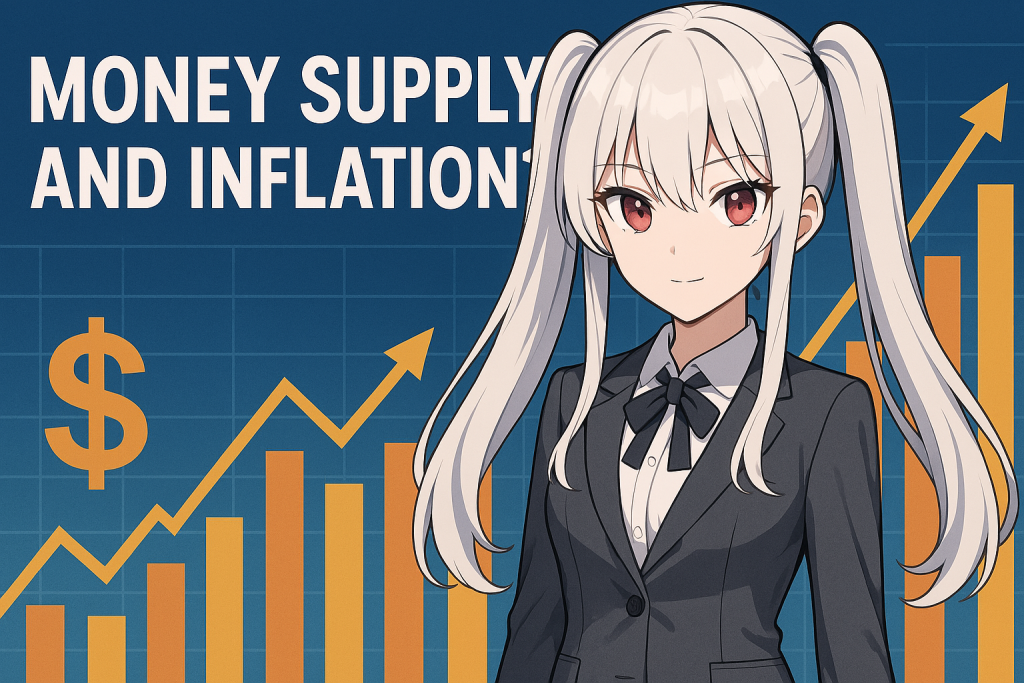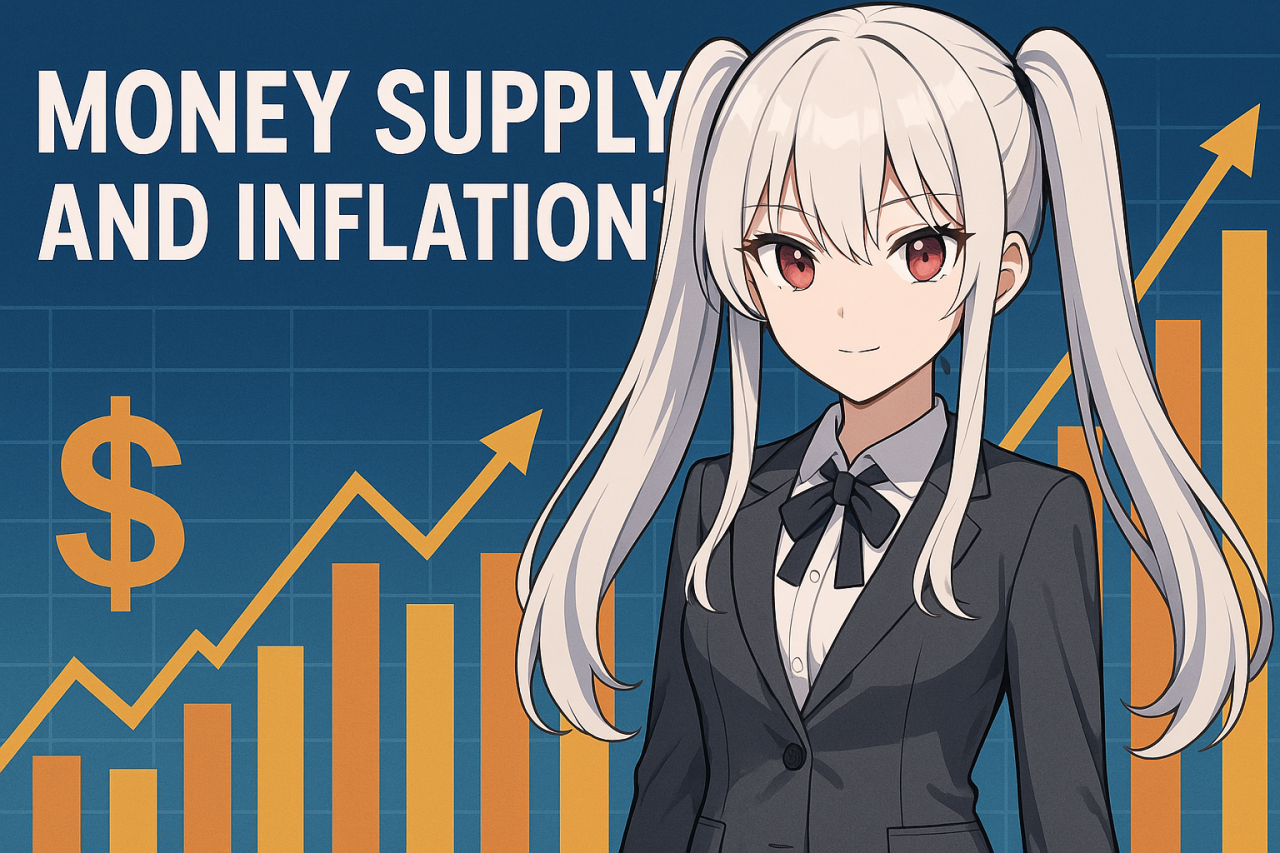What is the Money Supply? Understanding the Basics
Definition and Types of Money Supply
The money supply refers to the total amount of money circulating in a country’s economy. This includes not only cash currency directly managed by the central bank but also deposit currency held in commercial banks. The money supply is closely related to various economic indicators such as the scale of economic activity and inflation rate.
Multiple indicators such as M1, M2, and M3 are used to measure the money supply.
- M1: The sum of cash currency and demand deposits (such as ordinary deposits), representing the most liquid money.
- M2: In addition to M1, includes slightly less liquid deposits such as time deposits and savings deposits.
- M3: In addition to M2, includes a broader range of financial products such as negotiable deposits and investment trusts.
By using these indicators appropriately, you can analyze the flow of money in the entire economy in more detail. Proper management of the money supply is extremely important for economic stability and growth. The central bank plays a role in adjusting the money supply through monetary policy to prevent inflation and deflation.
What the Increase or Decrease of Money Supply Means
An increase in the money supply is generally considered to stimulate economic activity. As money circulates more in the market, companies find it easier to expand investment, and personal consumption tends to rise. However, a rapid increase in the money supply also carries the risk of inflation. As the value of money falls and prices rise, purchasing power can decline.
On the other hand, a decrease in the money supply can be seen as a sign of a recession. Companies find it difficult to raise funds and tend to curb investment. Personal consumption also weakens, and overall economic growth may slow.
Therefore, the central bank must manage the money supply appropriately and aim for economic stability and growth. In doing so, it is important to consider various economic indicators comprehensively and implement appropriate monetary policy. For example, the money supply can be controlled through interest rate adjustments and open market operations.
Bank of Japan’s Policies and Money Supply
The Bank of Japan (BOJ) is the central bank responsible for Japan’s monetary policy and aims for economic stability and growth through managing the money supply. The BOJ controls the money supply using various monetary policy tools such as interest rate adjustments and quantitative easing.
Interest rate adjustments influence corporate investment and personal consumption by steering short-term and long-term rates. When rates fall, companies find it easier to raise funds and tend to expand investment. Individuals also find it easier to borrow for things like mortgages, potentially boosting consumption.
Quantitative easing is a policy where the BOJ purchases assets such as government bonds to supply funds to the market. This is expected to increase the funds of financial institutions and promote lending to companies.
By appropriately combining these monetary policies, the BOJ adjusts the money supply to match economic conditions and prevents inflation and deflation. In recent years, new policy tools such as negative interest rate policy and yield curve control have also been introduced.
Inflation and the Money Supply Relationship
What is Inflation?
Inflation is an economic phenomenon in which the price level continuously rises over a period of time. This means that the value of money decreases relative, and you can only purchase fewer goods and services for the same amount of money than before. Inflation rates are usually measured using indicators such as the Consumer Price Index (CPI).
Moderate inflation can potentially promote economic growth. Companies anticipate rising prices and become more proactive in investing and production. Additionally, workers’ wages rise, boosting consumers’ purchasing enthusiasm.
However, excessive inflation can have adverse effects on the economy. When prices rise sharply, consumers curb spending due to anxiety about the future, and companies reduce investment. Inflation is advantageous for debtors but disadvantageous for creditors. Therefore, appropriately controlling the inflation rate is extremely important for economic stability. Central banks aim to manage inflation rates through monetary policy to achieve economic stability.
The Mechanism by Which an Increase in Money Supply Causes Inflation
An increase in the money supply is considered one of the factors that cause inflation. When the money supply increases, more money circulates in the market, boosting people’s purchasing power. As a result, demand for goods and services rises. If supply cannot keep up with the increased demand, prices rise and inflation occurs. This is the basic mechanism of inflation, where ‘demand exceeds supply’.
An increase in the money supply does not always lead to inflation. If the overall productive capacity of the economy is sufficiently high and can meet the increased demand, prices may remain stable. However, in reality, production capacity has limits, and an excessive increase in the money supply raises the risk of inflation.
Central banks implement monetary policy to appropriately manage the money supply and curb inflation. For example, by raising interest rates, they can restrain corporate investment and personal consumption, thereby reducing demand.
Differences from Deflation
Deflation, in contrast to inflation, is an economic phenomenon where prices continuously fall. Deflation can lead to sluggish consumption and deteriorating corporate earnings, potentially causing overall economic stagnation.
During deflation, consumers tend to postpone consumption in anticipation of future price declines. As a result, corporate sales fall and earnings deteriorate. Companies may cut wages or staff to improve earnings. This reduces consumers’ income, further dampening consumption and creating a vicious cycle.
Also, deflation is disadvantageous for debtors. When prices fall, the real burden of debt increases, making repayment difficult. Japan has suffered from deflation since the late 1990s, experiencing prolonged economic stagnation. To escape deflation, the government and central bank must cooperate and implement appropriate economic policies. For example, demand stimulation through fiscal policy and increasing the money supply via monetary easing can be effective.
Impact on Our Lives
How Inflation and Deflation Affect Household Finances
Inflation and deflation affect our household finances in various ways. During inflation, the prices of essential goods such as groceries and daily necessities rise, increasing household expenditures. This can make life more difficult, especially for low‑income households. Additionally, during inflation, the real value of deposits erodes, so measures to protect assets are necessary.
On the other hand, during deflation, prices fall, so household expenditures decrease. However, during deflation, corporate performance may deteriorate, wages may fall, and employment may become unstable. As a result, more people may curb consumption due to anxiety about the future, leading to overall economic stagnation.
Because inflation and deflation each have different impacts on household finances, it is important to keep track of the economic situation and manage household finances appropriately. For example, during inflation, it is essential to reduce unnecessary spending and focus on purchasing only what is needed.

Impact on Asset Management
Inflation and deflation also have a significant impact on asset management. During inflation, the value of cash erodes, making investment in tangible assets such as stocks and real estate advantageous. Stocks are considered inflation‑resistant assets because corporate earnings may increase with inflation. Real estate also tends to appreciate in price during inflation, making it an effective hedge.
Conversely, during deflation, the value of cash rises, making investment in safe assets such as deposits advantageous. Since stock and real estate prices may fall during deflation, it is wise to invest in safe assets to avoid risk.
However, in asset management it is important to consider the balance between risk and return. Even when investing in stocks and real estate as an inflation hedge, it is essential to diversify to reduce risk. Likewise, when investing in deposits as a deflation hedge, choosing high‑interest deposits and other measures to increase returns, even slightly, are important.
Impact on Corporate Management
Inflation and deflation also have a major impact on corporate management. During inflation, costs such as raw material and labor expenses rise, potentially squeezing corporate profits. Companies try to protect profits by passing cost increases onto prices, but if price pass‑through fails, profits may deteriorate. Additionally, financing costs rise during inflation, potentially restraining corporate investment activities.
Conversely, during deflation, price competition intensifies, potentially worsening corporate profits. Companies must implement measures such as cost reduction and operational efficiency to win price competition. Also, during deflation, demand weakens, making it difficult to develop new products and services.
Because inflation and deflation each affect corporate management differently, it is important to continuously monitor the economic situation and develop appropriate management strategies. For example, during inflation, companies should implement measures such as cost reduction and price pass‑through, and also consider strategies like exploring new markets.
Current State of Money Supply in Major Countries
Money Supply in the United States
In the United States, the Federal Reserve (FRB) adjusts the money supply through monetary policy. In recent years, the U.S. money supply has increased significantly. This is mainly due to the FRB implementing quantitative easing in response to the spread of COVID-19. Quantitative easing is a policy where the FRB purchases large amounts of assets such as government bonds and mortgage-backed securities to inject funds into the market. This policy increased the liquidity of financial institutions and promoted lending to businesses and individuals.
However, the rapid increase in money supply has raised concerns about higher inflation risk. The U.S. Consumer Price Index (CPI) recorded its highest growth rate in 40 years in 2022. The FRB has been raising rates since 2022 to curb inflation and plans to continue incremental rate hikes. Rate hikes are expected to restrain money supply growth and calm inflation.
Money Supply in the Eurozone
In the Eurozone, the European Central Bank (ECB) is responsible for monetary policy and manages the money supply. The Eurozone money supply has also been on an upward trend recently. This is mainly due to the ECB implementing quantitative easing and negative interest rate policies. Quantitative easing is a policy where the ECB purchases assets such as Eurozone government bonds to inject funds into the market. Negative interest rate policy applies a negative rate to funds that banks deposit with the ECB. This incentivizes banks to lend to businesses and individuals rather than deposit with the ECB, thereby increasing the money supply.
However, there are concerns that the increase in money supply in the Eurozone also raises inflation risk. The Eurozone Harmonised Index of Consumer Prices (HICP) has been on an upward trend recently, and the ECB has signaled a move toward normalizing monetary policy to curb inflation. However, uncertainties such as the worsening situation in Ukraine have heightened uncertainty in the Eurozone economy, making ECB policy management challenging.
Money Supply in Japan
In Japan, the Bank of Japan (BOJ) implements negative interest rate policy and quantitative and qualitative easing to aim for an increase in money supply. However, compared to the United States and Eurozone, Japan’s money supply growth rate remains at a lower level. This is attributed to factors such as Japan’s low economic growth rate and weak corporate investment appetite.
The BOJ has signaled a policy of continuing monetary easing to achieve a 2% price stability target. However, prolonged monetary easing has been noted to have side effects such as deteriorating bank profitability and loosening fiscal discipline. Moreover, with global inflation progressing, signs of rising prices are also appearing in Japan, and the BOJ’s policy management is facing a difficult phase. The BOJ needs to carefully assess price trends and implement appropriate monetary policy.
Summary: Understanding Money Supply and Predicting Economic Movements
Money supply is one of the most important indicators for grasping economic trends. Understanding its close relationship with economic phenomena such as inflation and deflation is essential for accurately recognizing the current state of the economy and predicting future movements.
Central banks around the world, including the Bank of Japan, adjust money supply through monetary policy to stabilize the economy. Understanding the intentions and effects of these policies is also important for predicting economic movements.
By comparing the current money supply of major economies, you can grasp global economic trends. Reports released by major financial institutions such as Mitsubishi UFJ Bank and Sumitomo Mitsui Banking Corporation provide detailed analysis and economic forecasts related to money supply, serving as valuable resources for information gathering.
Continuously gathering the latest information and analyzing the economy from multiple perspectives will enable more accurate predictions. Knowledge of money supply is also a valuable tool for personal investment decisions and corporate strategy. By flexibly responding to economic fluctuations and maximizing opportunities, let’s deepen our understanding of money supply.
Reference Sites
インフレとは何か。本稿では、足元で進行しているインフレのメカニズムを解説する。2008年の世界金融危機以降、投資家と経営…
LM曲線(LM Curve、えるえむきょくせん)とは、貨幣市場を均衡させる国民所得Yと金利iの組み合わせである。貨幣市場…











